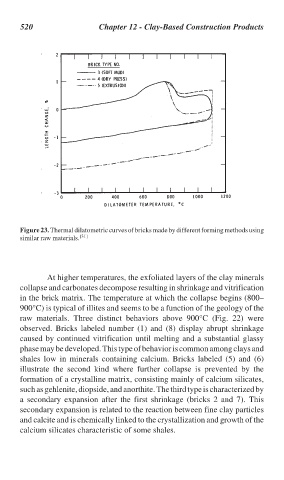Page 550 - Handbook of Thermal Analysis of Construction Materials
P. 550
520 Chapter 12 - Clay-Based Construction Products
Figure 23. Thermal dilatometric curves of bricks made by different forming methods using
similar raw materials. [31]
At higher temperatures, the exfoliated layers of the clay minerals
collapse and carbonates decompose resulting in shrinkage and vitrification
in the brick matrix. The temperature at which the collapse begins (800–
900°C) is typical of illites and seems to be a function of the geology of the
raw materials. Three distinct behaviors above 900°C (Fig. 22) were
observed. Bricks labeled number (1) and (8) display abrupt shrinkage
caused by continued vitrification until melting and a substantial glassy
phase may be developed. This type of behavior is common among clays and
shales low in minerals containing calcium. Bricks labeled (5) and (6)
illustrate the second kind where further collapse is prevented by the
formation of a crystalline matrix, consisting mainly of calcium silicates,
such as gehlenite, diopside, and anorthite. The third type is characterized by
a secondary expansion after the first shrinkage (bricks 2 and 7). This
secondary expansion is related to the reaction between fine clay particles
and calcite and is chemically linked to the crystallization and growth of the
calcium silicates characteristic of some shales.

